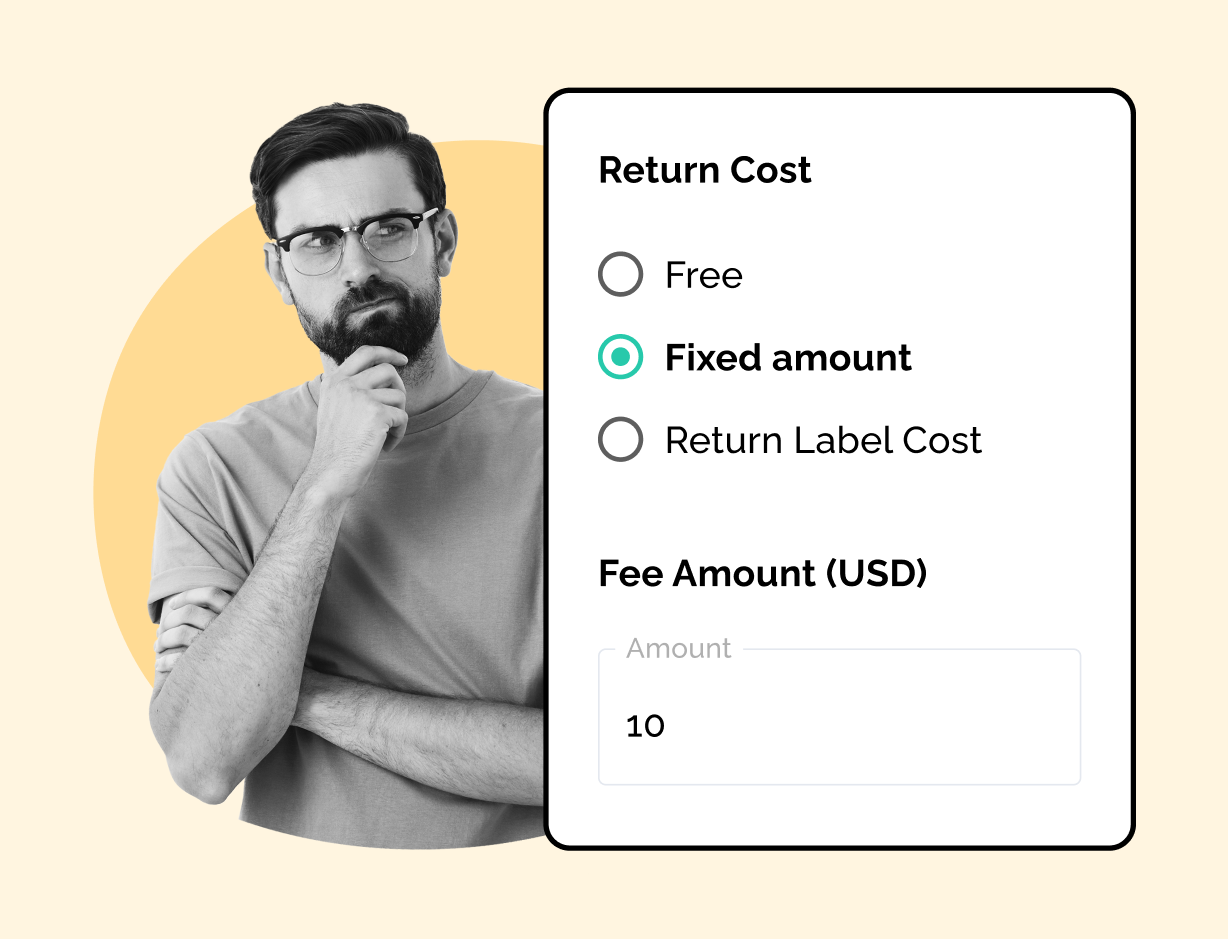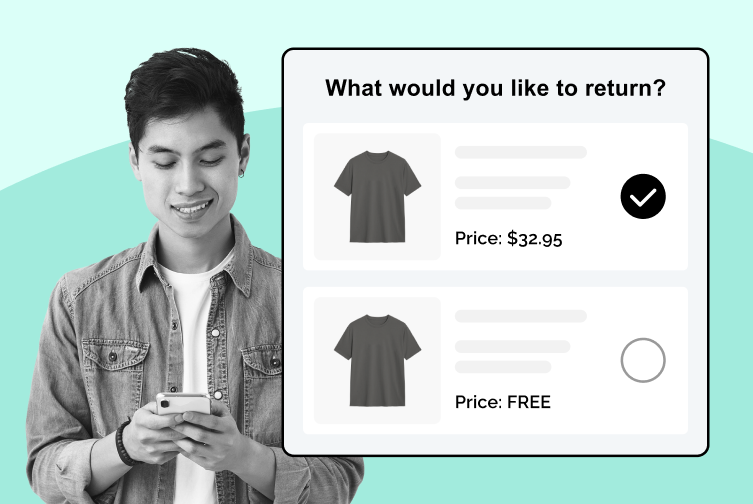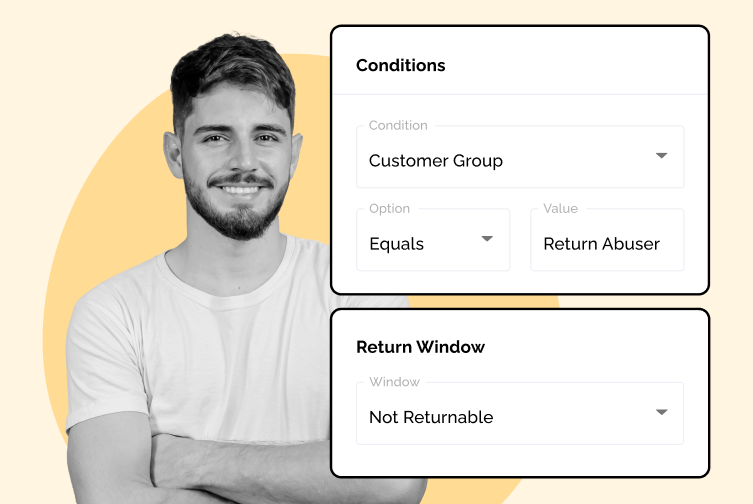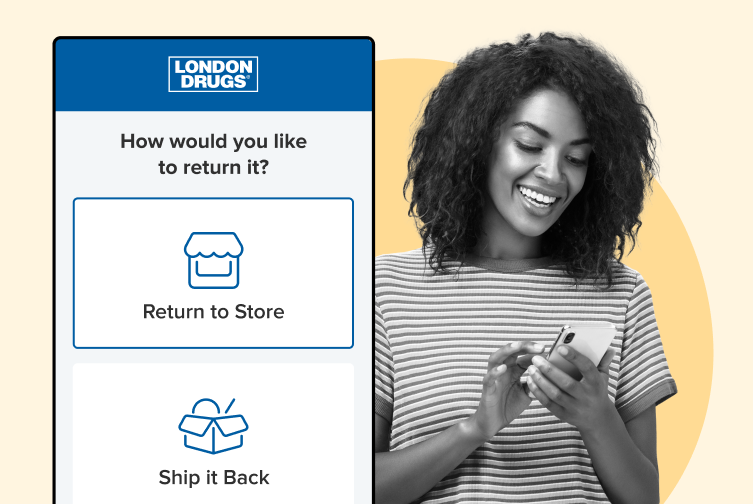
How to Reduce Returns With Real Time Product Feedback
Learn how to effectively manage promo bundle returns while protecting your revenue. Discover practical tips to streamline your process!
Shipping, Tracking & Notifications
Boost customer experience and reduce support tickets
Realtime order and shipment tracking
Proactive order and shipping notifications
AI-Enhanced Discounted Labels
Predictive pre-purchase estimated delivery dates
Self-Serivce branded order tracking
Effortless experience delivered
Identify and Resolve Order Issues
Realtime order and shipment tracking
Make returns profitable and delight customers
Flexibility to define any return destinations & conditions
Simplify returns for your customers and team
Incentivize exchanges over returns
Returns management made easy for your team
Returns management made easy for your team
Easy claims and smart upsells
Understand why your customers are returning
In-Store & Curbside Pickup
Unify the online and the in-store experience
Hassle-free pickup experience for customers
In-Store dashboard to keep operations streamlined
In-Store and Online orders unified
Drive foot-traffic to your stores
Shipping, Tracking & Notifications
Boost customer experience and reduce support tickets
Realtime order and shipment tracking
Proactive order and shipping notifications
AI-Enhanced Discounted Labels
Predictive pre-purchase estimated delivery dates
Self-Serivce branded order tracking
Effortless experience delivered
Identify and Resolve Order Issues
Realtime order and shipment tracking
Make returns profitable and delight customers
Flexibility to define any return destinations & conditions
Simplify returns for your customers and team
Incentivize exchanges over returns
Returns management made easy for your team
Returns management made easy for your team
Understand why your customers are returning
In-Store & Curbside Pickup
Unify the online and the in-store experience
Hassle-free pickup experience for customers
In-Store Dashboard to keep operations streamlined
In-Store and Online orders unified
Drive foot-traffic to your stores
Boost customer experience and reduce support tickets
Realtime order and shipment tracking
Proactive order and shipping notifications
AI-Enhanced Discounted Labels
Predictive pre-purchase estimated delivery dates
Self-Serivce branded order tracking
Effortless experience delivered
Make returns profitable and delight customers
Flexibility to define any return destinations & conditions
Simplify returns for your customers and team
Incentivize exchanges over returns
Returns management made easy for your team
Equip your team for precise return checks.
Easy claims and smart upsells
Understand why your customers are returning
Unify the online and the in-store experience
Hassle-free pickup experience for customers
In-Store Dashboard to keep operations streamlined
In-Store and Online orders unified
Drive foot-traffic to your stores
Find the answer to all your questions
Take a step by step trip through our functionality to see how we can improve your ecommerce processes.
Explore the most comon questions about WeSupply
Calculate the ROI that WeSupply can bring you
Read actionable articles on how to optimize your post-purchase experience and decrease support tickets
Get inspired by stories of how our customers implemented an effortless post-purchase experience
Wondering if WeSupply is a good fit for you? Read through our use cases to see how we can help you increase conversion & improve CX!
A Deep Dive into Top Companies' Order Tracking & Returns Strategy
Find the answer to all your questions
Explore the most comon questions about WeSupply
Calculate the ROI that WeSupply can bring you
Request a no strings attached review of your current shopping experience and missed conversion opportunities
Take a step by step trip through our functionality to see how we can improve your ecommerce processes.
Read actionable articles on how to optimize your post-purchase experience and decrease support tickets
Get inspired by stories of how our customers implemented an effortless post-purchase experience
A Deep Dive into Top Companies' Order Tracking & Returns Strategy
Wondering if WeSupply is a good fit for you? Read through our use cases to see how we can help you increase conversion & improve CX!

Ecommerce returns have become one of the biggest challenges for online retailers, cutting deep into profit margins and customer trust. With the average return rate hovering around 16.9%, businesses are looking beyond product quality to understand what’s fueling these returns. Surprisingly, one of the most overlooked contributors is shipping. From delivery speed to packaging quality, the shipping experience plays a crucial role in shaping whether a customer decides to keep a product or send it back.
Online shopping has heightened customer expectations for fast delivery and easy returns, making these factors central to customer satisfaction and influencing return rates.
In this article, we uncover the hidden connection between shipping and return rates, explaining how improving logistics can help retailers reduce returns, increase customer satisfaction, and build lasting loyalty.
Returns aren’t just inconvenient; they’re expensive. Every returned item represents lost revenue, additional shipping costs, restocking labor, and potential resale markdowns. For some retailers, returns can eat up as much as 30% of their margin. According to the National Retail Federation, managing returns is a top concern for many ecommerce businesses, especially with rising shipping and labor costs.
As return rates climb, businesses must rethink the entire post-purchase journey. Reducing returns not only protects profitability but also improves the overall shopping experience a crucial differentiator in a competitive market. Effective return management also helps prevent financial loss for the ecommerce business.
One major driver of product returns is a mismatch between customer expectations and the reality of what arrives at their doorstep. Transparency in shipping details such as accurate delivery windows, clearly communicated delivery time, specified time frame, upfront cost disclosures, and tracking visibility is essential for building trust.
When customers are promised a two-day delivery and it arrives in five, disappointment sets in. Even worse, a lack of communication during delays can lead to frustration and preemptive returns. Real-time tracking notifications via email or SMS, comprehensive tracking information, clear return policies, and dependable carriers all help prevent dissatisfaction and the potential for returns rooted in shipping confusion.
Additionally, the variety of delivery options a retailer offers, such as standard, express, or pick-up, can significantly shape customer expectations and satisfaction.
Shipping issues often trigger a chain reaction of problems. If an item arrives late, is damaged during transit, or is incorrectly packed, the customer is far more likely to return it. Returned products are shipped back to the retailer or fulfillment center for inspection and restocking. A crushed box, missing accessory, or wrong item can completely undermine the excitement of a new purchase.
High-return product categories like electronics and apparel are particularly vulnerable. For example, improper packaging can damage a smartphone or tablet, leading to costly returns and customer churn. The same goes for fashion items, such as a t shirt, sent without protective wrapping that get wrinkled or stained and need to be returned.
Getting fulfillment right the first time not only saves money but also prevents headaches for both customers and support teams. How you ship products using secure packaging and accurate fulfillment plays a crucial role in reducing returns.
Today’s shoppers are empowered by convenience and that includes the ability to return items easily. While this boosts sales, it also encourages purchasing behaviors like “bracketing,” where customers order multiple items or the same product in different sizes or colors with the intention of returning most of them.
According to ECR Retail Loss, 41% of ecommerce shoppers admit to buying multiple versions of a product, knowing they’ll return some. This behavior is particularly common in categories like apparel, where fit and color are hard to judge online. For example, a customer may order a t shirt in several sizes and return the ones that are the wrong size after they have purchased and evaluated the items at home. Free returns and fast delivery facilitate this behavior, making it easier for consumers to treat their homes like fitting rooms.
While bracketing may be a necessary evil in online retail, retailers can mitigate it with better product visuals, detailed sizing guides to help prevent wrong size returns, and customer reviews along with shipping strategies that set realistic expectations.
Shipping speed is now a baseline expectation, not a bonus. With giants like Amazon offering same-day delivery or next-day delivery, customers expect fast fulfillment from every brand. Shipping speed is a major factor in customer satisfaction. Missed delivery windows or inconsistent timelines can erode trust and lead to returns.
Retailers that under-promise and over-deliver on online orders often see higher satisfaction scores. If a brand promises five-day delivery and the item arrives in three, the customer is pleasantly surprised. On the other hand, a late delivery especially with no communication can turn excitement into buyer’s remorse.
Accuracy is just as important. A fast delivery means nothing if the wrong item shows up. Investing in warehouse management systems and order verification processes can help ensure accuracy and reduce return-inducing mistakes.
Coordinating shipping across multiple sales channels is essential to ensure a consistent and reliable customer experience.
Packaging may seem minor, but it’s a frontline defense against damage-related returns. The number of items sold is directly affected by packaging quality, as damaged goods lead to higher return rates. Protective materials, right-sized boxes, and clear labeling (like “fragile” or “this side up”) help ensure products arrive intact.
Beyond function, packaging is also a branding opportunity. A well-packaged product can delight customers and reinforce brand value. Unboxing experiences that feel thoughtful and premium can reduce return impulse especially in gifting scenarios.
Conversely, poor packaging creates doubt about a company’s professionalism and care. If a product looks like it was hastily tossed into a reused box, customers may question its quality and be more likely to send it back. Clear product descriptions and detailed product pages help most customers make informed decisions, reducing the likelihood of returns due to misunderstandings or inaccurate information.
Many retailers and most retailers now offer free returns and free shipping to stay competitive. Free return shipping is increasingly seen as a standard rather than a perk. According to Mailmodo, 69% of customers expect it. Yet only 49% of retailers currently offer it, largely due to cost concerns.
Offering free returns and free shipping can increase purchase rates and improve conversion rate by boosting customer confidence. These strategies signal trust telling customers, “We stand by our product” and can build loyalty while lowering long-term return costs.
It makes sense for some retailers to absorb return fees in order to build customer loyalty and encourage repeat business. While these policies can invite more returns, especially from casual buyers or serial returners, the increase in repeat business often more than offsets the expense.
Even when returns are necessary, the process should be as painless as possible. Shoppers are far more likely to buy again from a brand that offers a hassle free return policy, which is essential for customer satisfaction.
Features like pre-printed return labels, online return portals, and multiple drop-off options all help create a frictionless process. Online returns are a growing trend, and return management apps help save time by automating procedures and streamlining inventory updates. In-store returns for online purchases are also increasingly popular, with 62% of shoppers saying they’re more likely to buy from a retailer that offers this option. Physical stores play a key role in the returns process by handling item inspections, restocking inventory, and managing reverse logistics.
Retailers that make returns easy not only reduce customer frustration but also shorten the time it takes to restock and resell items preserving inventory value and customer goodwill.
For online retailers, having a return policy is only half the battle measuring its effectiveness is what truly drives improvement. By tracking the right metrics, ecommerce businesses can gain a clear picture of how their return policies impact customer satisfaction, profit margins, and overall business health.
One of the most critical metrics is the return rate itself, which reveals the percentage of online purchases that are sent back. Monitoring this over time helps retailers spot trends and identify problem areas, whether it’s a specific product category or a particular sales channel.
Another key indicator is the repeat purchase rate among customers who have made returns. A high rate suggests that your return policies are fostering trust and encouraging loyalty, while a low rate may signal customer dissatisfaction with the returns process.
The average time to process a return from the moment a customer initiates the return to when they receive a refund or store credit also plays a major role in customer satisfaction. Faster processing times keep customers happy and more likely to shop again.
Cost per return is another essential metric, as it directly affects profit margins. This includes shipping costs, restocking fees, and any loss in resale value. By understanding these costs, online retailers can make informed decisions about whether to offer free return shipping or adjust their return policies to better balance customer expectations with financial realities.
Finally, collecting and analyzing customer feedback on the returns process provides valuable qualitative insights. Surveys and reviews can highlight pain points and help retailers fine-tune their approach for happier customers and lower return rates.
By keeping a close eye on these metrics, ecommerce businesses can ensure their return policies are not only meeting customer needs but also supporting long-term profitability and growth.
Shipping and return experiences don’t just affect the immediate sale they shape the entire customer relationship. A single negative experience can lead to lost customers and negative reviews, while a positive experience can drive customer loyalty and create repeat customers, increasing lifetime value.
According to Red Stag Fulfillment, 96% of customers are more likely to shop again if the return process is easy. Conversely, 50% of shoppers say they won’t buy again after a poor shipping experience.
Happy customers return fewer products because they feel more confident in the brand. They also tend to shop more frequently and refer others, making them far more valuable over time. Understanding customer preferences allows businesses to tailor the experience, further increasing satisfaction and retention.
Reducing returns isn’t just about customer satisfaction; it’s a smart financial strategy. ECR Retail Loss reports that a 5% improvement in return rate can add up to 200 basis points to a retailer’s net margin. Offering a full refund as part of your return policy can be a strong incentive for customers, increasing their confidence in making a purchase.
That means optimizing shipping and returns isn’t just good CX it’s good business. Shipping and return policies directly influence purchasing decisions, as customers are more likely to complete transactions when they know returns are easy and risk-free. By investing in better fulfillment technology, packaging, and communication tools, ecommerce brands can lower costs, increase efficiency, and improve margins.
Shipping should be treated as a conversion tool, not just a cost center. When done well, it boosts loyalty, reduces churn, and improves your bottom line. Additionally, special events like holidays or major sales can significantly impact return rates and overall profitability, making it even more important to have robust shipping and return strategies in place.
Sustainability is an increasingly important factor for online shoppers. Excessive packaging, unnecessary shipments, and inefficient reverse logistics all add to an ecommerce brand’s carbon footprint.
A poor shipping experience that leads to returns doubles the environmental cost of that order. Brands that prioritize eco-friendly packaging, consolidate shipments, and reduce return rates can attract environmentally conscious consumers and enhance brand reputation.
Being green isn’t just about optics it’s about efficiency. Reducing waste and unnecessary returns contributes to both a healthier planet and a more sustainable business model.
Not all products are returned for the same reasons. Apparel returns are often driven by sizing and fit, while electronics may be returned due to defects or damage. Beauty products may have hygiene concerns, and furniture is subject to damage or mismatch expectations.
Understanding the reasons behind returns in each category helps retailers design more effective shipping and return strategies. This might include virtual try-on tools for fashion, better product visuals for electronics, or custom-fit packaging for fragile items.
Tailored strategies not only reduce returns but also enhance the customer experience across different product types.
Behind every return lies a moment of customer doubt often triggered not by the product itself, but by the shipping experience. Whether it’s a missed delivery window, damaged packaging, or a lack of real-time updates, poor shipping can quickly lead to frustration and, ultimately, a return.
That’s where WeSupply steps in.
WeSupply helps ecommerce brands bridge the gap between expectation and experience by transforming how you handle shipping and post-purchase communication. The result? Fewer returns, happier customers, and stronger margins.
Here’s how WeSupply tackles the hidden link between shipping and returns:
🕒 Delivery Transparency & Accurate ETAs
Set realistic expectations with dynamic delivery estimates and delay alerts that prevent customer disappointment from late arrivals.
🛍️ Proactive Issue Management
Detect problems early with AI-powered shipment visibility and offer proactive solutions (like re-shipments or discounts) before customers even think about returning.
🔁 Seamless Returns Experience
Simplify returns with self-service portals, drop-off options, and flexible label generation — making even necessary returns feel frictionless and brand-positive.
📊 Data-Driven Insights to Reduce Returns
Spot high-return SKUs, detect shipping-related return trends, and continuously improve both fulfillment and packaging based on real customer behavior.
🔄 Omnichannel Support for In-Store & Online
Unify returns and exchanges across every channel to create a consistent experience that builds trust — no matter how customers shop.
🛡️ Shipping & Return Protection
Let customers opt in to purchase insurance on their orders and returns, adding peace of mind while reducing financial risk for both your brand and your buyers.
The takeaway? When you fix your shipping experience with WeSupply, your return rates naturally drop because you’re preventing issues before they happen.
Shipping isn’t just a backend operation. It’s a critical touchpoint in the customer journey and WeSupply gives you the tools to get it right, every time.
Reduce returns. Rebuild trust. Retain customers. That’s the WeSupply difference. Book a demo!
The link between shipping and return rates may be hidden, but its impact is undeniable. Every detail from delivery speed and packaging quality to communication and return convenience can tip the scale between a keeper and a return.
With WeSupply, ecommerce brands gain the tools to close this gap. Features like real-time tracking, accurate ETAs, proactive issue resolution, seamless return portals, and Shipping & Return Protection empower you to create a smooth, trustworthy experience from checkout to doorstep and beyond. By treating shipping as a key part of the customer journey, not just a backend operation, you reduce return rates, boost customer satisfaction, and build lasting loyalty.
Fix your shipping with WeSupply, and your returns and your bottom line will follow.
Eliminate shipping anxiety
Book a quick call with our experts to see how WeSupply can help you fulfill customer demands and gain long-term trust by clearly addressing shipping insurance.
Combat inconvenience with proactivity & self service
Book a quick call with our experts to see how WeSupply can help you make returns easy for your customers with a beautiful, self-service solution that makes their experience easier while also providing new ways to lower costs and earn back revenue.
1. How does poor shipping lead to higher return rates in ecommerce?
Late deliveries, damaged packaging, or incorrect items can break customer trust and prompt returns—even when the product is fine. A disappointing shipping experience often turns excitement into regret, increasing the likelihood of a return.
2. Why is shipping speed important for reducing return rates?
Fast and accurate shipping meets customer expectations and prevents buyer’s remorse. When deliveries arrive on time—or earlier—customers are more likely to keep their orders and return to buy again.
3. What’s the impact of shipping transparency on return rates?
Clear delivery windows, real-time tracking, and proactive delay alerts help manage expectations and prevent returns triggered by confusion or frustration over shipping status.
4. How does WeSupply reduce ecommerce return rates?
WeSupply reduces return rates by improving the shipping experience with real-time tracking, proactive alerts, accurate ETAs, and data insights that help fix fulfillment issues before they lead to returns.
5. What WeSupply tools help prevent returns caused by shipping problems?
WeSupply offers branded tracking notifications, issue detection, delivery transparency, and seamless return portals to ensure customers stay informed and satisfied from checkout to delivery.
6. Can WeSupply improve both shipping and returns across channels?
Yes. WeSupply supports omnichannel return and shipping experiences online and in-store creating consistency and trust across all touchpoints, which helps reduce churn and encourage repeat purchases.
7. Does WeSupply have an Official Shopify App?
Yes. WeSupply has an Official Shopify App. You can download it and start integrating with your Shopify Store.
8. Does WeSupply have an official Magento extension?
Yes, WeSupply has an official extension for Magento. The WeSupply x Magento integration allows for automating order tracking experiences, reducing customer inquiries, automating shipping email and SMS notifications, and providing a fully branded order tracking experience.
9. Does WeSupply have an official BigCommerce App?
Yes, WeSupply has an official BigCommerce App. You can integrate WeSupply with your BigCommerce store to improve your post-purchase customer experience.
Learn How To Create Successful Post Purchase Email Campaigns
Build an effective post-purchase email flow that helps you increase customer satisfaction and drive revenue growth!

Learn how to effectively manage promo bundle returns while protecting your revenue. Discover practical tips to streamline your process!

Learn how to manage BOGO returns effectively while ensuring customers aren’t charged for the free item. Practical solutions!

Explore how automation and data can enhance your shipping strategy. Discover best practices to stay competitive and efficient. Read the article now!

Discover effective strategies to prevent return promo abuse with smart logic. Enhance your business’s integrity!

Learn how to effectively manage promo bundle returns while protecting your revenue. Discover practical tips to streamline your process!

Boost your revenue by turning returns into opportunities with personalized upsell offers. Discover effective strategies!

Discover 7 essential tips for implementing eco-friendly shipping practices that boost your brand’s sustainability!

Explore how automation and data can enhance your shipping strategy. Discover best practices to stay competitive and efficient. Read the article now!

Discover how AI-powered eCommerce shipping solutions can streamline operations and boost customer satisfaction!